Optimum Efficiency of a Steam Ejector for Fire Suppression Based on the Variable Mixing Section Diameter
Abstract
:1. Introduction
- a)
- Comprehensive numerical simulations using various mixing section diameters were performed to examine the link between geometry and the steam ejector pumping efficiency.
- b)
- The simulation was validated with experimental results to approve the accuracy of the research. In addition, different turbulent models with supported wall functions were considered for optimization prediction certainty.
- c)
- The fluid flow characteristics under different mixing section diameters were analyzed and discussed in detail.
- d)
- The influence of ejector back pressure on ejector efficiency under different mixing section diameters was analyzed, and the critical back pressure under certain conditions was analysed and discussed.
- e)
- The influence of diameter on flow characteristics was simulated to study the optimization of steam ejector performance under certain operating conditions.
2. Numerical Algorithms
2.1. Governing Equations
2.2. Ejector Geometry and Mesh Sensitive Analysis
2.3. Numerical Simulation Settings
3. CFD Model Verification
4. Results and Discussion
4.1. The Effect on the Boundary Layer Separation
4.2. The Effect on the Choking Flow
4.3. The Effect on the Entrainment Ratio
4.4. The Effect on the Critical Back Pressure
5. Conclusions
- 1)
- The research results show that the high primary pressure of the ejector reduces the secondary fluid flow area. The entrainment ratio of the ejector decreases accordingly.
- 2)
- Under certain operating conditions, expanding the diameter of the mixing section, such as the diffuser, can improve the pumping performance of the ejector and reduce its ultimate exhaust capacity. When the diameter increases from 24 mm to 28 mm, the entrainment ratio of the steam ejector improves by 89.29%, but the critical back pressure of the steam ejector drops by 21.43%.
- 3)
- When the diameter of the mixing section is less than 48 mm, the entrainment ratio increases gradually with the diameter increase. When the diameter of the mixing section is larger than 48 mm, the ejector entrainment ratio decreases with the growth of the diameter. When the diameter is 48 mm, the entrainment ratio reaches the maximum value of 0.81.
- 4)
- Under certain working conditions and diameters, the entrainment ratio remains unchanged. Currently, the back pressure value is the critical back pressure value. Beyond this value, the entrainment ratio plummets until the ejector becomes a failure entirely.
- 5)
- For a specific steam ejector fire extinguishing system, the optimal structure with the highest exhaust efficiency can be found by optimizing the crucial geometric parameters of the ejector on the premise of considering the exhaust efficiency and the limited exhaust capacity.
Author Contributions
Funding
Institutional Review Board Statement
Data Availability Statement
Conflicts of Interest
References
- Grant, G.; Brenton, J.; Drysdale, D. Fire suppression by water sprays. Prog. Energy Combust. Sci. 2000, 26, 79–130. [Google Scholar] [CrossRef]
- Yoon, S.; Hewson, J.; DesJardin, P.; Glaze, D.; Black, A.; Skaggs, R. Numerical modeling and experimental measurements of a high speed solid-cone water spray for use in fire suppression applications. Int. J. Multiph. Flow 2004, 30, 1369–1388. [Google Scholar] [CrossRef]
- Tang, Y.; Liu, Z.; Li, Y.; Wu, H.; Zhang, X.; Yang, N. Visualization experimental study of the condensing flow regime in the transonic mixing process of desalination-oriented steam ejector. Energy Convers. Manag. 2019, 197, 111849. [Google Scholar] [CrossRef]
- Tang, Y.; Liu, Z.; Li, Y.; Yang, N.; Wan, Y.; Chua, K.J. A double-choking theory as an explanation of the evolution laws of ejector performance with various operational and geometrical parameters. Energy Convers. Manag. 2020, 206, 112499. [Google Scholar] [CrossRef]
- Ebadollahi, M.; Rostamzadeh, H.; Pourali, O.; Ghaebi, H.; Amidpour, M. Inherently safety design of a dual-loop bi-evaporator combined cooling and power system: 4E and safety based optimization approach. Process Saf. Environ. Prot. 2021, 154, 393–409. [Google Scholar] [CrossRef]
- Wang, X.; Wang, L.; Song, Y.; Deng, J.; Zhan, Y. Optimal design of two-stage ejector for subzero refrigeration system on fishing vessel. Appl. Therm. Eng. 2021, 187, 116565. [Google Scholar] [CrossRef]
- Gu, R.; Sun, M.; Cai, Z.; Chen, J.; Li, P.; Dong, Z.; Wang, T.; Yao, Y.; Huang, Y. Experimental study on the rocket-ejector system with a throat in the secondary stream. Aerosp. Sci. Technol. 2021, 113, 106697. [Google Scholar] [CrossRef]
- Wang, C.; Yuen, A.C.Y.; Chan, Q.N.; Chen, T.B.Y.; Chen, Q.; Cao, R.; Yip, H.L.; Kook, S.; Yeoh, G.H. Influence of Eddy-Generation Mechanism on the Characteristic of On-Source Fire Whirl. Appl. Sci. 2019, 9, 3989. [Google Scholar] [CrossRef] [Green Version]
- Nakamura, Y.; Usuki, T.; Wakatsuki, K. Novel Fire Extinguisher Method Using Vacuuming Force Applicable to Space Habitats. Fire Technol. 2019, 56, 361–384. [Google Scholar] [CrossRef]
- Yinshui, L.; Zhuo, J.; Dan, W.; Xiaohui, L. Experimental research on the water mist fire suppression performance in an enclosed space by changing the characteristics of nozzles. Exp. Therm. Fluid Sci. 2014, 52, 174–181. [Google Scholar] [CrossRef]
- Yang, P.; Liu, T.; Qin, X. Experimental and numerical study on water mist suppression system on room fire. Build. Environ. 2010, 45, 2309–2316. [Google Scholar] [CrossRef]
- Beji, T.; Zadeh, S.E.; Maragkos, G.; Merci, B. Influence of the particle injection rate, droplet size distribution and volume flux angular distribution on the results and computational time of water spray CFD simulations. Fire Saf. J. 2017, 91, 586–595. [Google Scholar] [CrossRef] [Green Version]
- Besagni, G.; Mereu, R.; Inzoli, F. Ejector refrigeration: A comprehensive review. Renew. Sustain. Energy Rev. 2016, 53, 373–407. [Google Scholar] [CrossRef] [Green Version]
- Tashtoush, B.M.; Al-Nimr, M.d.A.; Khasawneh, M.A. A comprehensive review of ejector design, performance, and applications. Appl. Energy 2019, 240, 138–172. [Google Scholar] [CrossRef]
- Matsuo, K. Shock train and pseudo-shock phenomena in supersonic internal flows. J. Therm. Sci. 2003, 12, 204–208. [Google Scholar] [CrossRef]
- Yin, X.; Wang, X.; Wang, L.; Qin, B.; Liu, H.; Jia, L.; Cai, W. Cooperative control of air and fuel feeding for PEM fuel cell with ejector-driven recirculation. Appl. Therm. Eng. 2021, 199, 117590. [Google Scholar] [CrossRef]
- Ariafar, K.; Buttsworth, D.; Al-Doori, G.; Sharifi, N. Mixing layer effects on the entrainment ratio in steam ejectors through ideal gas computational simulations. Energy 2016, 95, 380–392. [Google Scholar] [CrossRef]
- Han, Y.; Guo, L.; Wang, X.; Yuen, A.C.Y.; Li, C.; Cao, R.; Liu, H.; Chen, T.B.Y.; Tu, J.; Yeoh, G.H. A steam ejector refrigeration system powered by engine combustion waste heat: Part 1. characterization of the internal flow structure. Appl. Sci. 2019, 9, 4275. [Google Scholar] [CrossRef] [Green Version]
- Han, Y.; Wang, X.; Guo, L.; Yuen, A.C.Y.; Liu, H.; Cao, R.; Wang, C.; Li, C.; Tu, J.; Yeoh, G.H. A steam ejector refrigeration system powered by engine combustion waste heat: Part 2. understanding the nature of the shock wave structure. Appl. Sci. 2019, 9, 4435. [Google Scholar] [CrossRef] [Green Version]
- Wang, L.; Cai, W.; Zhao, H.; Lin, C.; Yan, J. Experimentation and cycle performance prediction of hybrid A/C system using automobile exhaust waste heat. Appl. Therm. Eng. 2016, 94, 314–323. [Google Scholar] [CrossRef]
- Hamner, R.M. An alternate source of cooling-the ejector-compression heat-pump. Ashrae J.-Am. Soc. Heat. Refrig. Air-Cond. Eng. 1980, 22, 62–66. [Google Scholar]
- Sun, D.-W. Experimental investigation of the performance characteristics of a steam jet refrigeration system. Energy Sources 1997, 19, 349–367. [Google Scholar] [CrossRef]
- Sriveerakul, T.; Aphornratana, S.; Chunnanond, K. Performance prediction of steam ejector using computational fluid dynamics: Part 1. Validation of the CFD results. Int. J. Therm. Sci. 2007, 46, 812–822. [Google Scholar] [CrossRef]
- Sriveerakul, T.; Aphornratana, S.; Chunnanond, K. Performance prediction of steam ejector using computational fluid dynamics: Part 2. Flow structure of a steam ejector influenced by operating pressures and geometries. Int. J. Therm. Sci. 2007, 46, 823–833. [Google Scholar] [CrossRef]
- Riffat, S.; Jiang, L.; Gan, G. Recent development in ejector technology—A review. Int. J. Ambient. Energy 2005, 26, 13–26. [Google Scholar] [CrossRef]
- Chen, J.; Jarall, S.; Havtun, H.; Palm, B. A review on versatile ejector applications in refrigeration systems. Renew. Sustain. Energy Rev. 2015, 49, 67–90. [Google Scholar] [CrossRef]
- Bartosiewicz, Y.; Aidoun, Z.; Desevaux, P.; Mercadier, Y. Numerical and experimental investigations on supersonic ejectors. Int. J. Heat Fluid Flow 2005, 26, 56–70. [Google Scholar] [CrossRef]
- Wen, C.; Li, B.; Ding, H.; Akrami, M.; Zhang, H.; Yang, Y. Thermodynamics analysis of CO2 condensation in supersonic flows for the potential of clean offshore natural gas processing. Appl. Energy 2022, 310, 118523. [Google Scholar] [CrossRef]
- Wen, C.; Ding, H.; Yang, Y. Numerical simulation of nanodroplet generation of water vapour in high-pressure supersonic flows for the potential of clean natural gas dehydration. Energy Convers. Manag. 2021, 231, 113853. [Google Scholar] [CrossRef]
- Pianthong, K.; Seehanam, W.; Behnia, M.; Sriveerakul, T.; Aphornratana, S. Investigation and improvement of ejector refrigeration system using computational fluid dynamics technique. Energy Convers. Manag. 2007, 48, 2556–2564. [Google Scholar] [CrossRef]



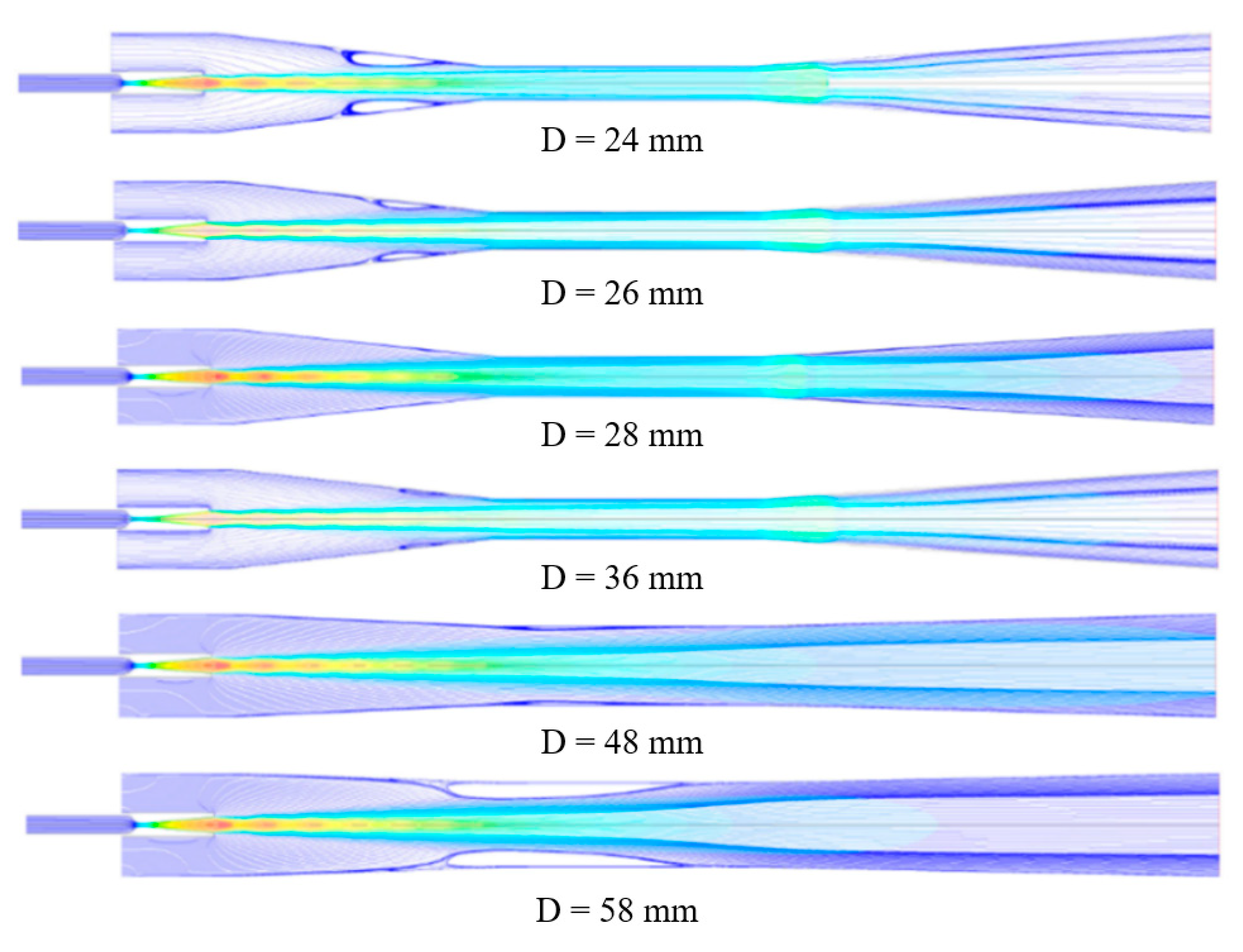
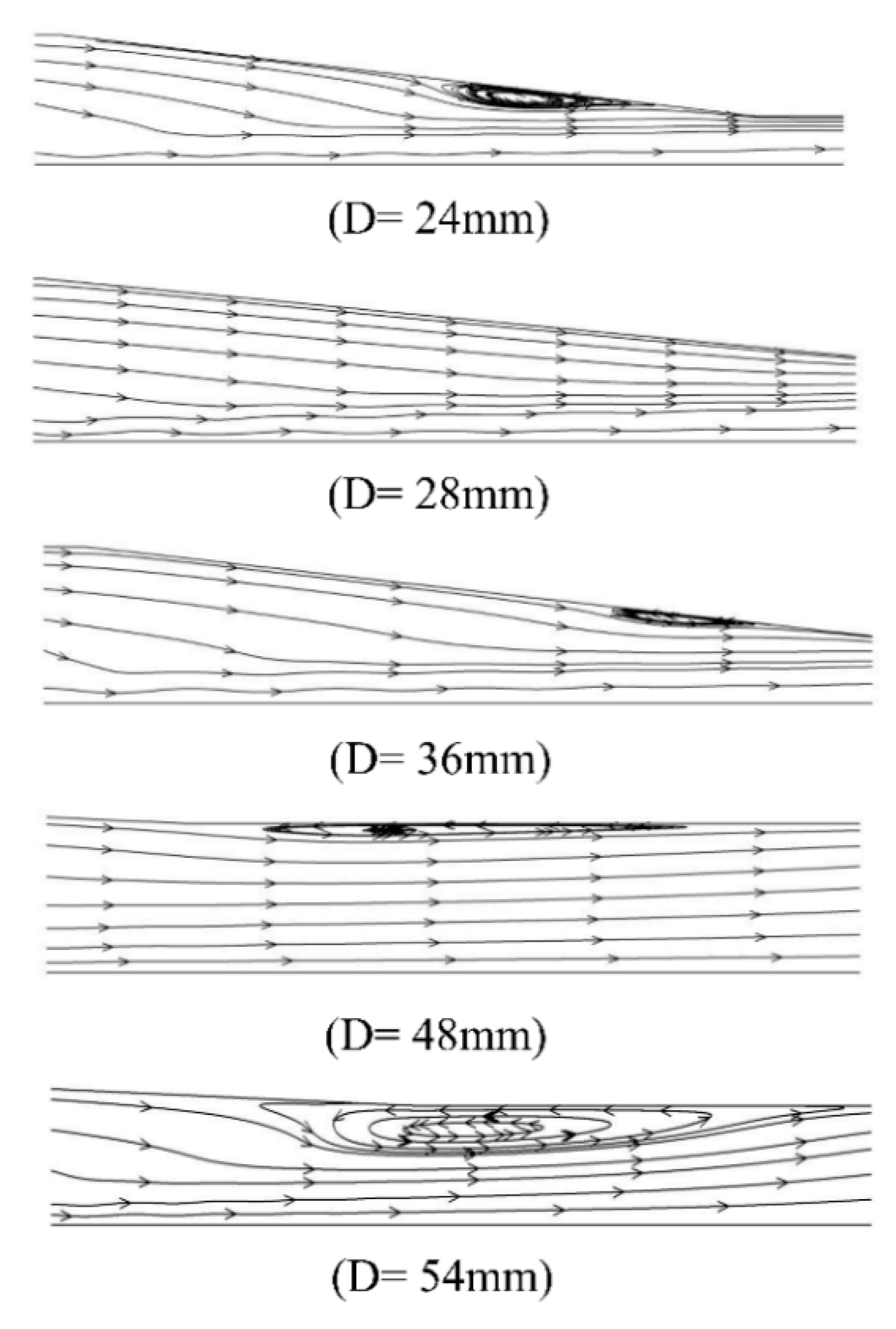
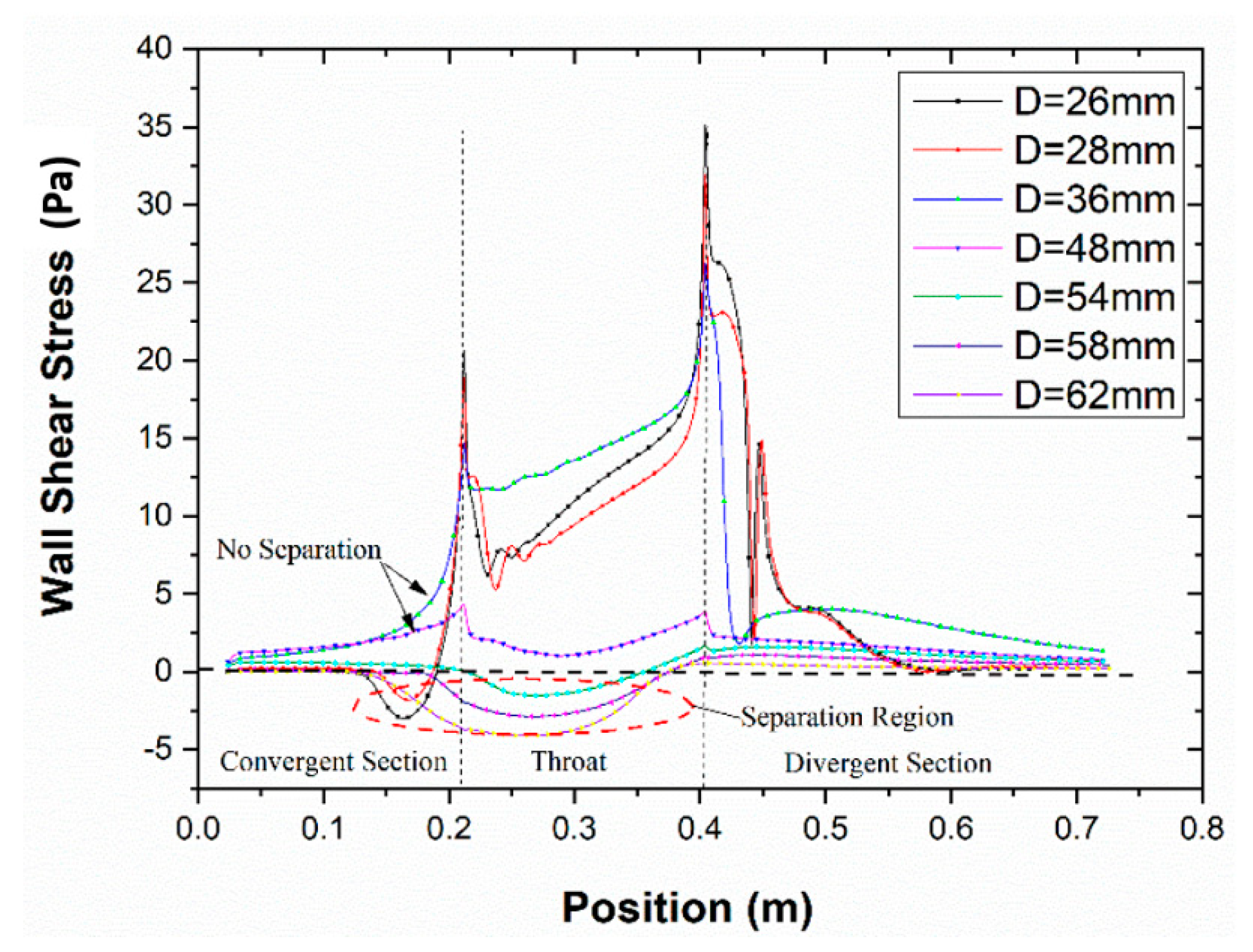
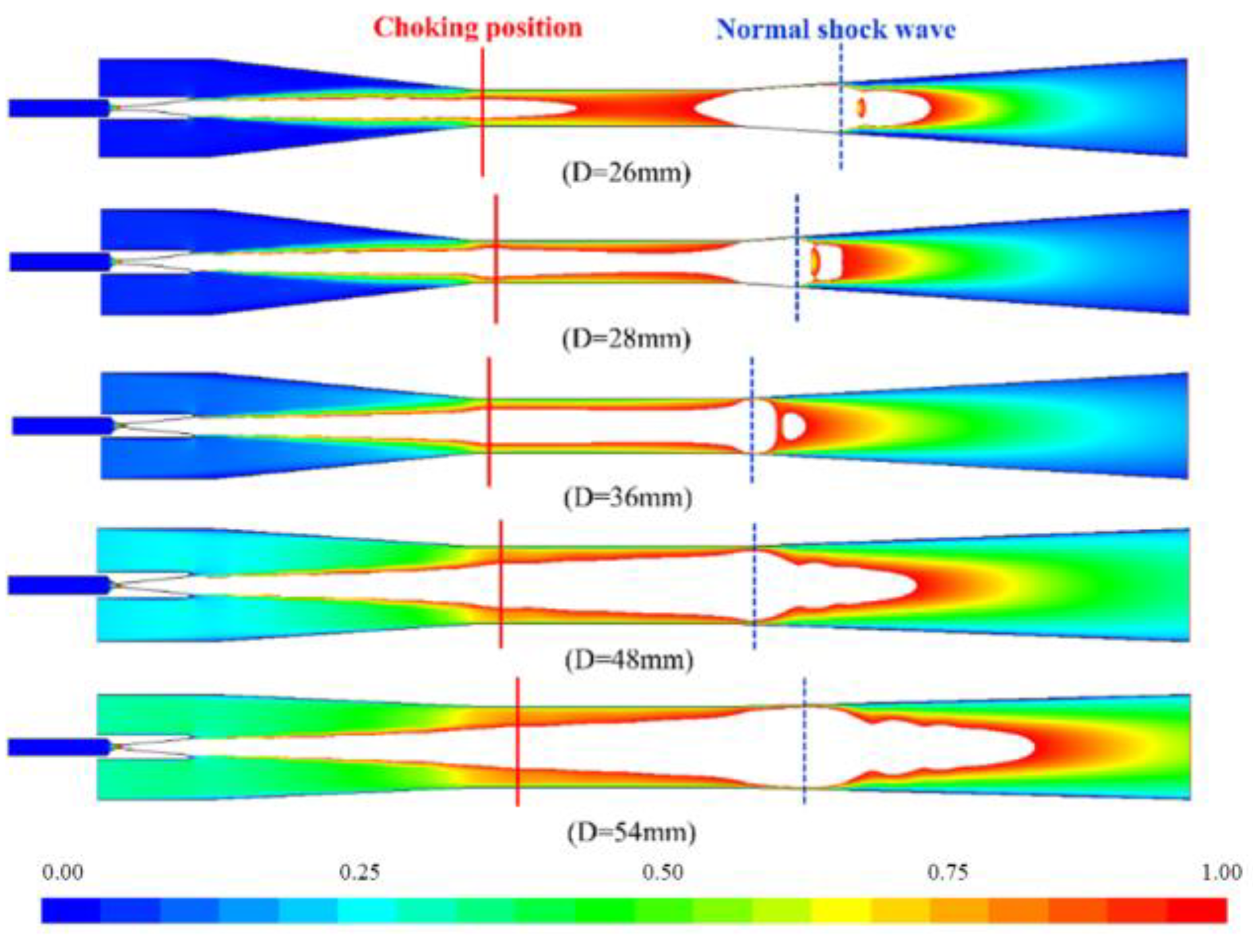
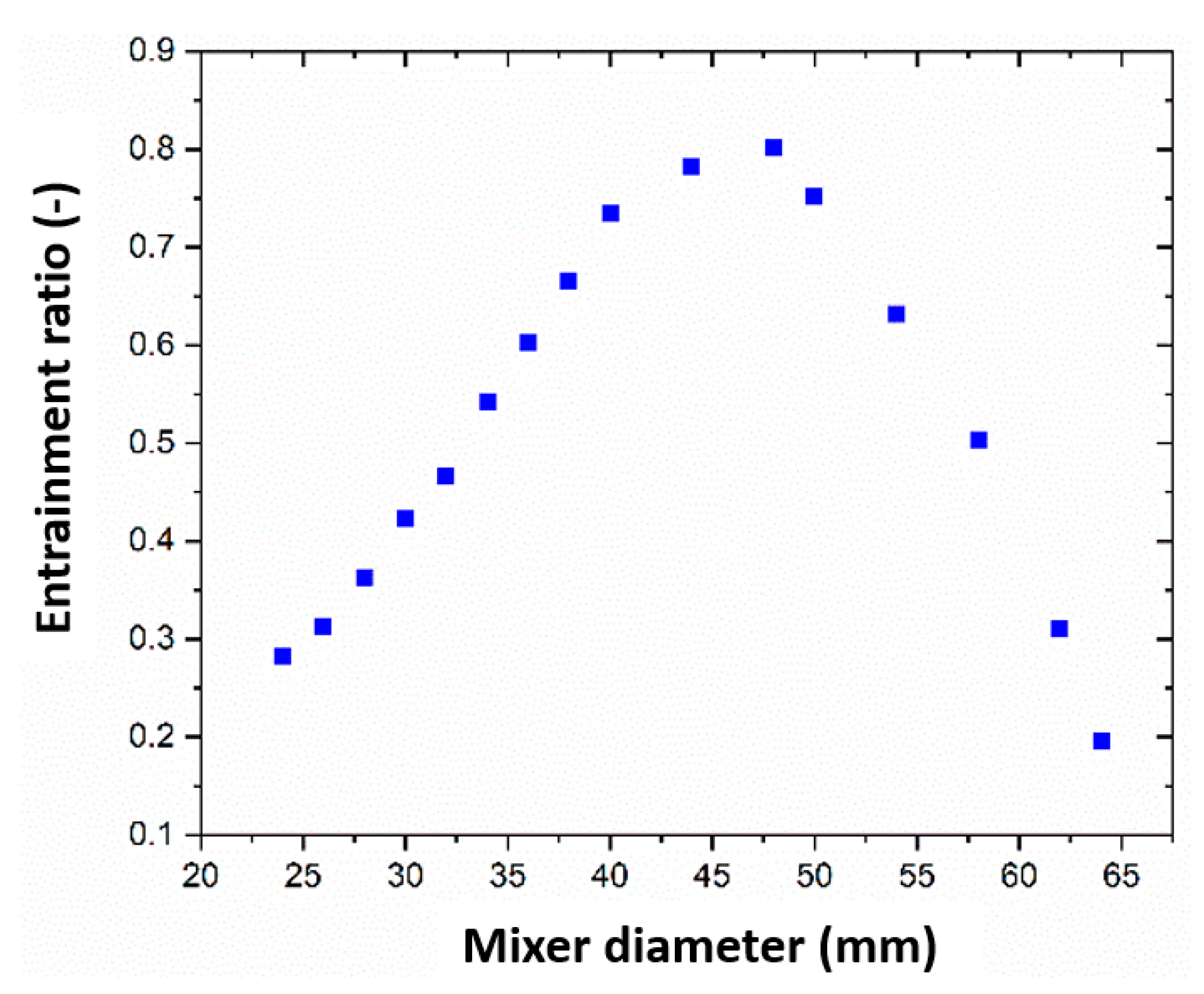
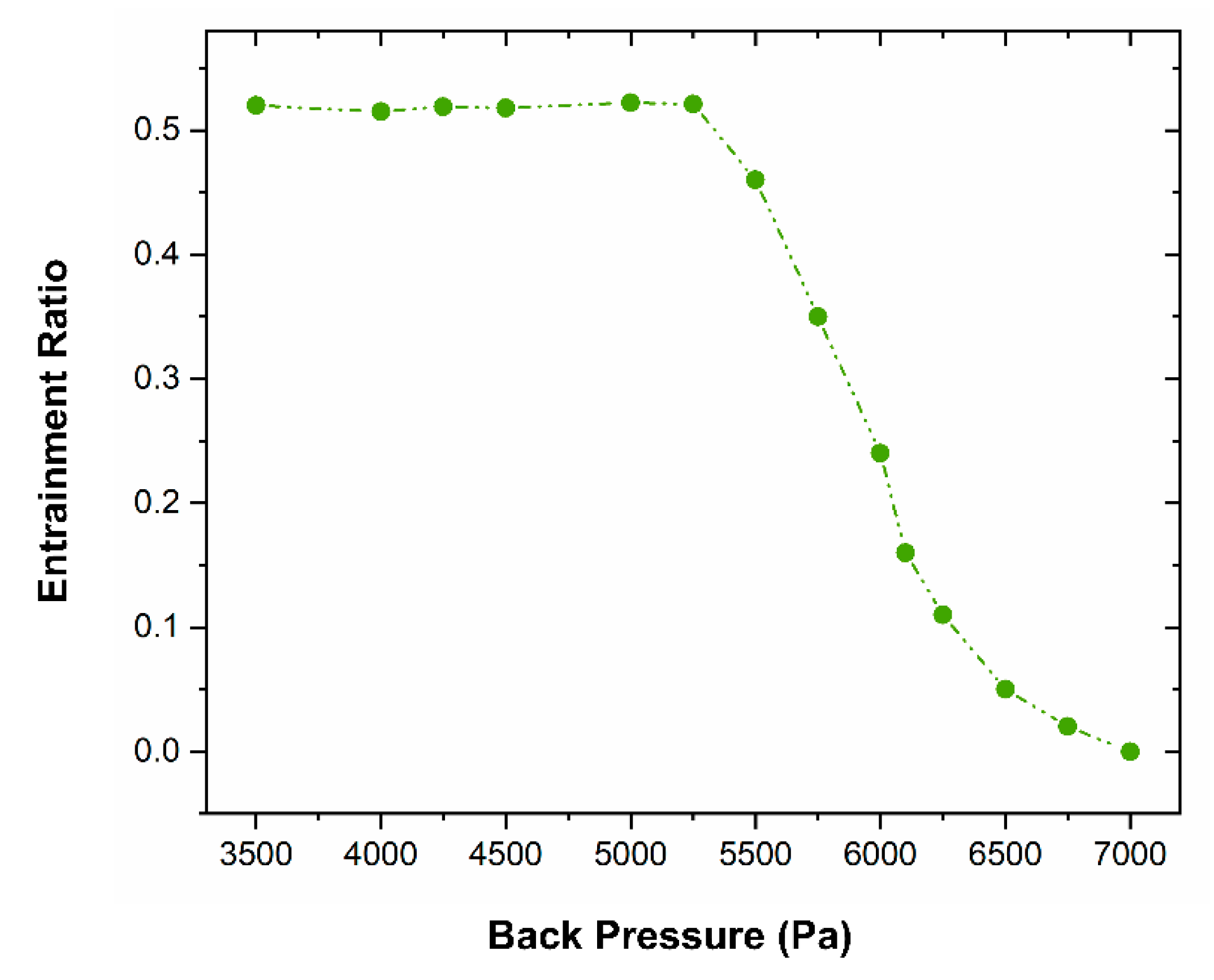
| Parameter | Value and Unit |
|---|---|
| Primary nozzle inlet diameter | 12 mm |
| Primary nozzle outlet diameter | 11 mm |
| Primary nozzle throat diameter | 2.5 mm |
| Nozzle expanded angle | 10° |
| Nozzle exit position | 10 mm |
| Mixing chamber inlet diameter | 70 mm |
| throat diameter | 28 mm |
| Mixing chamber length | 122.2 mm |
| Throat length | 90 mm |
| Subsonic diffuser length | 210 mm |
Publisher’s Note: MDPI stays neutral with regard to jurisdictional claims in published maps and institutional affiliations. |
© 2022 by the authors. Licensee MDPI, Basel, Switzerland. This article is an open access article distributed under the terms and conditions of the Creative Commons Attribution (CC BY) license (https://creativecommons.org/licenses/by/4.0/).
Share and Cite
Han, Y.; Wang, X.; Li, A.; A. Elbarghthi, A.F.; Wen, C. Optimum Efficiency of a Steam Ejector for Fire Suppression Based on the Variable Mixing Section Diameter. Entropy 2022, 24, 1625. https://doi.org/10.3390/e24111625
Han Y, Wang X, Li A, A. Elbarghthi AF, Wen C. Optimum Efficiency of a Steam Ejector for Fire Suppression Based on the Variable Mixing Section Diameter. Entropy. 2022; 24(11):1625. https://doi.org/10.3390/e24111625
Chicago/Turabian StyleHan, Yu, Xiaodong Wang, Ao Li, Anas F. A. Elbarghthi, and Chuang Wen. 2022. "Optimum Efficiency of a Steam Ejector for Fire Suppression Based on the Variable Mixing Section Diameter" Entropy 24, no. 11: 1625. https://doi.org/10.3390/e24111625






